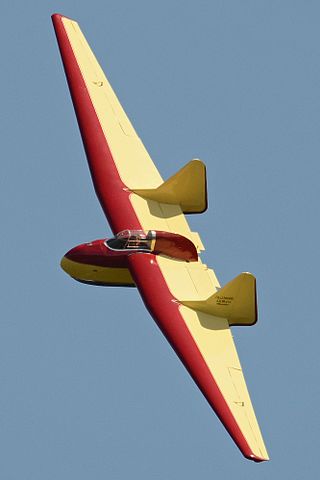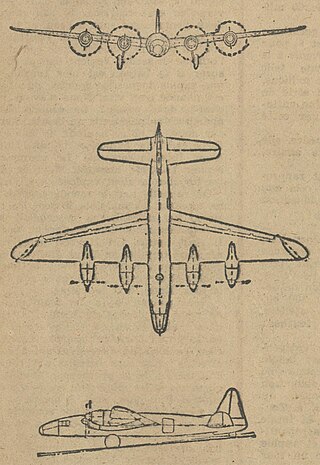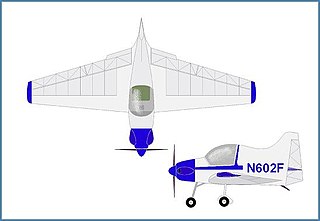Related Research Articles
A circular wing is a disc-shaped wing having the outer planform of a circle.

The Fauvel AV.36 was a single-seat tailless glider designed in France in the 1950s by Charles Fauvel. Although the "AV" in AV.36 stands for Aile Volante, it was not a true flying wing: it featured two large fins mounted on stubby tailbooms extending back from the wing's trailing edge, and accommodated the pilot within a stubby fuselage. The aircraft was designed to be quickly disassembled for road transport, with the nose detaching, and the fins able to fold back against the trailing edge of the wing. A refined version with a slightly longer wingspan, the AV.361 was introduced in 1960.
Charles Fauvel was a French aircraft designer noted for his tailless and flying wing designs and, in particular, his sailplanes. Fauvel became interested in soaring after witnessing a competition at Vauville in 1925, and set out to design a competition glider with minimal drag, settling on the flying wing formula based on the work of Georges Abrial and René Arnoux. One of his designs, the AV.10 was the first tailless design to attain a French Certificate of Navigability. His greatest commercial success was the AV.36 sailplane, first flown in 1951.

The Fokker F.XXXVI was a 1930s Dutch four-engined 32-passenger airliner designed and built by Fokker. It was the largest transport designed and built by Fokker.

The Supermarine Air Yacht was a British luxury passenger-carrying flying boat. It was designed by Supermarine's chief designer R. J. Mitchell and built in Woolston, Southampton in 1929. It was commissioned by the brewing magnate Ernest Guinness, and was the first British flying yacht built to the order of a private owner. Only one machine was built.
The Fauvel AV.44 was a design for an unorthodox light aircraft produced in France in the 1970s. The work of Charles Fauvel, it was based on his pre-war AV.10 and like it, was a tailless monoplane with a reverse-delta planform and side-by-side seating in an enclosed cabin. The AV.44 featured considerably more modern aerodynamics and accommodation for two passengers in place of the AV.10's one. Five examples were under construction in 1977.
The Fauvel AV.50 Lutin was a design for an unorthodox light aircraft produced in France in the 1970s. Like some other Charles Fauvel designs, it was a tailless aircraft with a reverse-delta wing. In this case, it was a single-seater intended to be powered by a converted Volkswagen engine. Only one example was known to have been under construction by 1977, in Australia.
The Fauvel AV.45 was an unorthodox motor glider produced in France in the 1960s and 1970s. Like other Charles Fauvel designs, it was a tailless aircraft, in this case inspired by the work that German firms had done on producing motorised versions of his AV.36 design. The prototype of the AV.45 was an extensively modified AV.36 powered by a Nelson H-59 two-stroke engine. AV.45s have been built with a number of other engines, however, including at least one aircraft powered by a small turbojet. Falconar marketed the plans in the 1970s.

The Fauvel AV.22 was an unorthodox glider produced in France in the 1950s, 60s, and 70s. Originally intended to be produced in series, it was later marketed to homebuilders. Like other Charles Fauvel designs, it was a tailless aircraft, and this particular design featured wings with a slight forward sweep.
The Air Est JCD 03 Pelican is a French mid-wing, twin tailed, flying wing single-seat motor glider that was designed by Jean-Claude Debreyer and produced by Air Est Services of Marly, Moselle and supplied as a kit for amateur construction or as a complete aircraft.

The SNCASE SE-1010 was a late 1940s French photo-survey aircraft designed and built by SNCASE for the Institut Géographique National, one prototype was built but it crashed and the project was cancelled.

The Fauvel AV.2 (AV for aile volante was the first Fauvel type to fly, completed in 1932.
The Tupolev Tu-404 was a wide-body superjumbo blended wing jet airliner proposed by Russian aerospace company Tupolev.

The Fauvel AV.10 was a tailless light aircraft built in France by Charles Fauvel. A two-seater side-by-side and equipped with a 75 hp engine, it first flew in 1935. Designed by Charles Fauvel, it was his first powered aircraft, designed from the outset as that, to have been realised. In 1936, it had been exhibited at the 25th Salon de L'Aéronautique at the Grand-Palais of Paris. The AV-10 was a one-off design and disappeared in 1940, when it's believed it was taken by German troops.

The Fauvel AV.60 (AV for aile volante was a flying wing tourism aircraft built in France in the early 1960s. It was a low-wing monoplane of wooden construction, featuring a flying wing layout.
The Fauvel AV.42 was a (AV for aile volante tail-less tourism cabin monoplane designed, but not built, in France.
The Fauvel AV.46 was a (AV for aile volante was a 2-seat tail-less motor-glider designed, but not built, in France. The AV.46 was derived from the single-seat Fauvel AV.45, fitted with a dual tandem cockpit similar to the Fauvel AV.22.
The Fauvel AV.28 was a design for a fighter plane by Charles Fauvel in the late 1930s.
The Fauvel AV.29 was a design for a transport plane by Charles Fauvel in the late 1930s.
The Fauvel AV.7 was a design for a twin-hull seaplane by Charles Fauvel in the early 1930s.